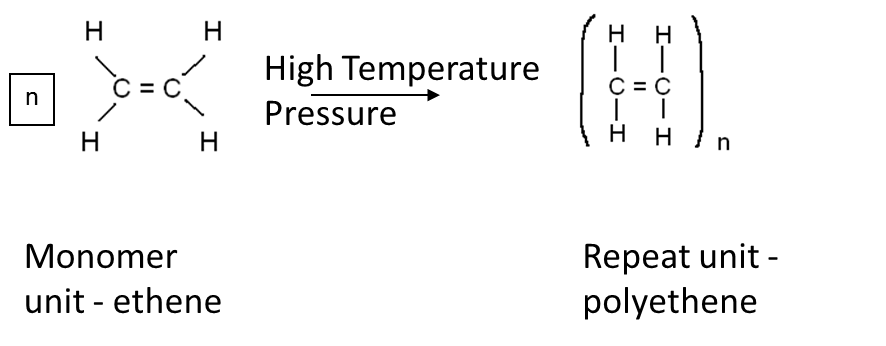


Products from crude oil
What you need to know
Reflections and Exam tips
Products from crude oil
Cracking
In order to meet the high demand for useful fractions such as petrol, longer (low demand/ high supply) hydrocarbon chains are broken down using heat (800°C) and a catalyst, into these shorter chained hydrocarbons. This is a thermal decomposition reaction (breaking down substance using heat).
Cracking produces an alkane and alkene from cracking a large alkane hydrocarbon. For example, Decane --> Octane + Ethene
Alkanes versus alkenes
- All have 4 bonds per carbon
- Alkanes = single bonds (saturated hydrocarbon)
- Alkenes = at least one double bond (unsaturated hydrocarbon)
Due to the presence of the double C=C bond (unsaturated), alkenes are more reactive. To test for unsaturated C=C bond, bromine water is used which changes from orange/yellow to a clear and colourless solution (decolurised).
Polymerisation
Making large polymer chains (many units) from many small monomers (single unit) bonded together.
Requires a double bond to work
Monomer units like ethene are heated with a catalyst. The double bond is broken and turned into a single bond during the process and the monomers join up to form a polymer, polyethene.

New types of polymers
New types of polymers have been developed that changes in response to its environment called smart polymers.
Shape memory polymers
These are used to stitch a wound loosely, and heat from your body temperature causes the polymer to tighten and close the wound. The polymers are designed to dissolve to reduce the need to get the stitch removed.
Light-sensitive plasters
The polymer in the plaster reacts when exposed to light so that it becomes less sticky and therefore easier to remove from the skin and hairs.
Hydrogels
Hydrogels contain polymer that absorbs water. These polymers are used in disposable nappies, water crystals for plants and hair gel.
Plastic waste
Plastics are made from crude oil, which is running out (finite).
Disadvantages of plastic disposal methods
Landfill
Large areas for landfill sites are needed and they are running out.
Many plastics are non-biodegradable (doesn’t break down in the environment).
Burning/incineration
Releases toxic chemicals into atmosphere.
Volume of waste is reduced but the ash produced can be toxic.
Recycling
High fuel costs due to transportation as well production of greenhouse gases which can cause global warming.
High cost involved in sorting plastics before they are recycled.
Some plastics cannot be recycled.
Bio-plastics:
These are generally a mix of traditional oil based plastic and plant based (usually corn starch) plastic. Plastic is strong and biodegradable. This helps preserve oil supplies which is the raw material for plastics. However, as they are crop based problems such as the amount of crops grown for food decreases which can cause food prices to skyrocket. Furthermore, some bioplastics will only break down when exposed to light and not underground.
Ethanol
Ethanol can be produced from ethene or fermentation of plant materials.
| Fermentation | Hydration |
|---|---|
Biological (made from plants) and renewable Fermented from any sugary source (e.g. sugar cane), using yeast enzymes. Temperature not higher than 40 °C. Simple technology used. Yield is limited as the yeast is poisoned by the ethanol. Ethanol is impure. Batch process (slow process). CO2 produced (Greenhouse gas) |
Chemical (ethene) resource is non renewable. Large hydrocarbons are cracked to make ethene, steam added (water), with a catalyst. Temperature of about 300°C. Higher technology required. Produces higher yields of ethanol. Ethanol is pure. Continuous process (faster). 100% atom economy |
Describe how useful substances can be obtained from crude oil
Describe the process of polymerisation
Ethanol can be produced in two different ways:
1) from alkenes
2) fermentation by yeast
Discuss the advantages and disadvantages of each method